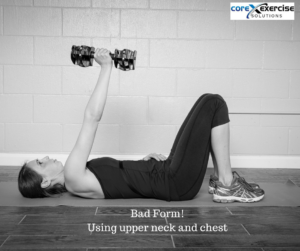Did you know your shoulder connects to your core? This vital connection helps align your neck with your trunk and is one of the best kept secrets for perfect posture. Not only does it help banish neck pain for good but it also helps your obliques fire more efficiently, along with creating massive “core” strength.
I’m talking about a muscle called the serratus anterior. It’s your new secret weapon!
Things this muscle does well:
- Alleviates shoulder or neck pain during forward tasks (computer, cooking, etc.)
- Alleviates burning pain in midback area
- Helps you hold a plank without winging shoulder blades while enhancing core activation (more results for your time)
- Perfects a push up
- Increases upper body strength from co-activation of more muscles
- Looks great in a strapless dress
- Increased lymphatic drainage
- Did I mention neck tightness, midback and shoulder pain? A great serratus anterior is the key for aligning your entire body.

So why haven’t you heard about it? Because it’s not one you can easily see and people only work what they can see… unless of course you were cast in the movie 300, because all those guys had awesome serratus muscles!
Having great abs has to do with how well your external obliques fire. One factor in a great oblique contraction is getting a full exhale. A major factor dictating an exhale is the starting point: you must first get a great inhale. That’s where the serratus anterior comes in. This muscle helps spread the ribs for a great inhale. Talk about a full circle powerhouse of muscle!!

From a systemic perspective, the serratus plays a major role in shoulder positioning which can enhance lymphatic drainage. Your lymphatic system helps to transport toxins. Correct alignment helps this system. Not to mention it’s really annoying when a hand goes numb!
How do we activate this muscle? It’s not always easy because cheaters like to get involved. Cheaters are those muscles that like to work for everything, but should really be taking a break. The pec minor (a chest muscle) is one of those. The serratus should fire when you reach forward - whether that’s for your coffee cup or to hold a plank - but the pec minor will often take over for this creating a very tight upper chest, neck tightness and further weakening of the serratus.
Step 1: Decrease the cheaters! On this first exercise, we are going to do this by putting a band around your elbows. Push out on the band just as much as you need to get your chest to fully let go but no more than that.
Step 2: Turn on your core. In the picture, I have my feet in a split stance, which is great for a starting point, but once you master the movement, try adopting a tall plank position on the wall. (Feet and hips square, ribs down, chin tucked, belly not sagged)
Step 3: Add weight or make it harder! Once you get this perfected, grab a dumbbell to press over your head. Then keep advancing things to the 3rd exercise that involves a full plank.
Wall Roll Ups
Coaching notes:
- Tuck your chin and keep your ribs down
- As your arms roll up the wall do not let your belly or low back move even a mm.
- Keep your wrists closer to the wall than your elbows. If you let your wrist come away from the wall, you will substitute triceps for serratus.
- Keep your neck 100% relaxed as you roll up the wall. Pause every inch if you need to and move your head side to side to make sure your neck is relaxed.
- Think about leading with your pinkies and pushing up the wall from under your arms, not with the top of your shoulders.
This is a highly effective exercise - if you do it right!
A slightly easier exercise, but one often harder to get right is a simple press.
Single Arm Press
Coaching Notes:
- Lie on your back, spine in neutral and chin tucked
- Press your arm up toward the ceiling
- Think about pressing through your pinky, pushing up from underneath your arm, if it helps, stick your pinky out
- Focus on feeling your neck relax
- Start by pressing up, then focus on holding the weight in the air and doing small circles, never letting your scapula drop down
The last exercise is extremely challenging. Start by just trying to hold in the right position and then advance to doing small circles.
Planks on a Ball
**** Do not do this exercise if you have a diastasis (abdominal separation)****
Click here to find out how to check for a diastasis.
Coaching Notes:
- Utilize a perfect plank positioning (Find out more here.)
- Keep your chin tucked and hands WAY AWAY from your face
- Do not let your bottom sag or stick up in the air
- Think about connecting your ribs
- Be sure to breathe! Inhale- Exhale- deep breathing, not shallow.
This is an advanced exercise and only to be used once the other two are mastered and you are confident in taking your core + serratus strength to the next level!
Working with pregnant and postpartum clients/patients?
This 6-part course offers key takeaways on breathing, pelvic floor strengthening and diastasis recovery. Sign up and start learning today!










